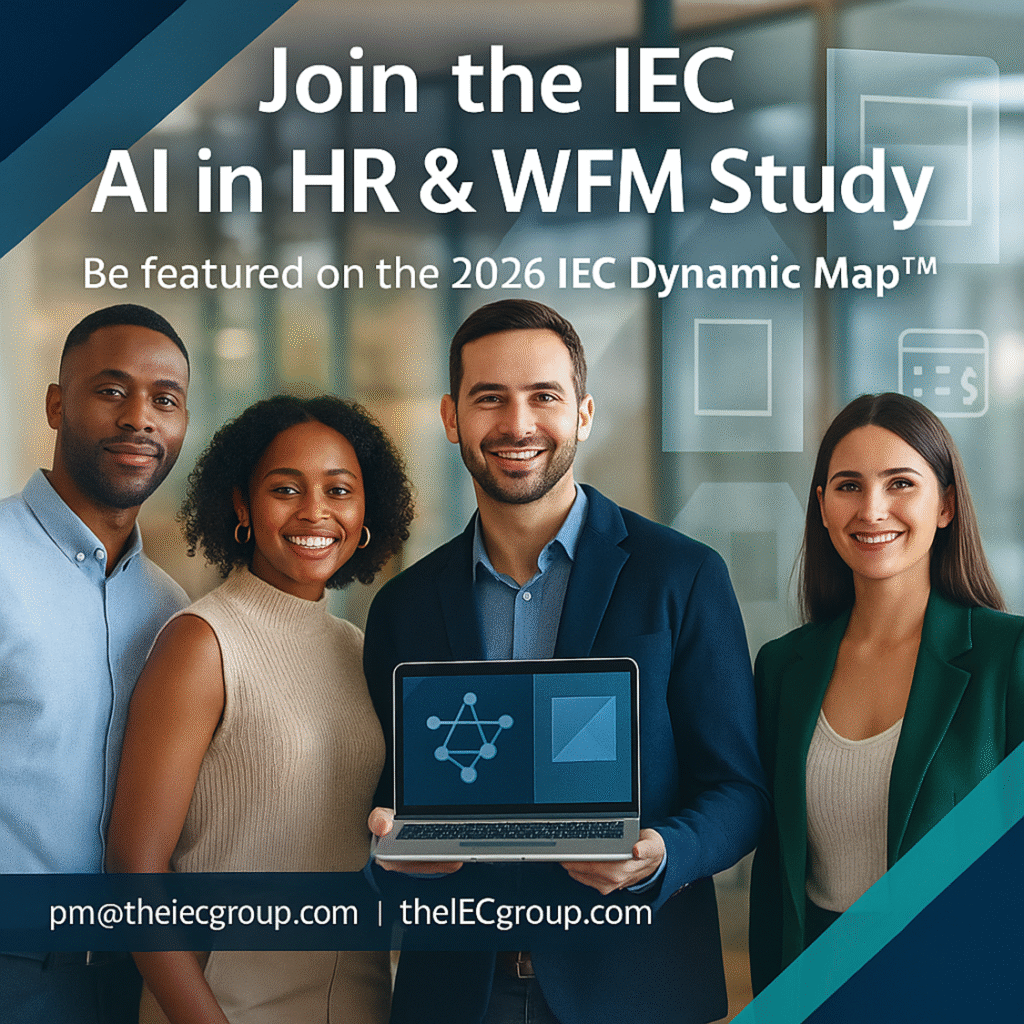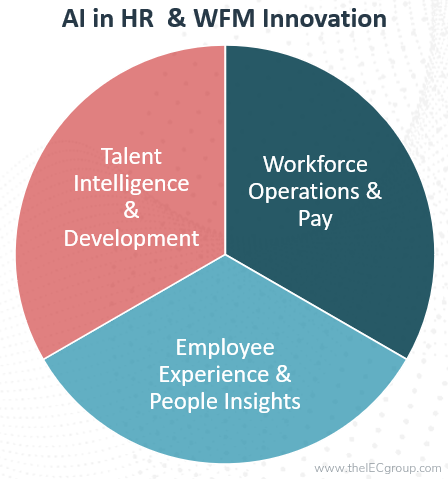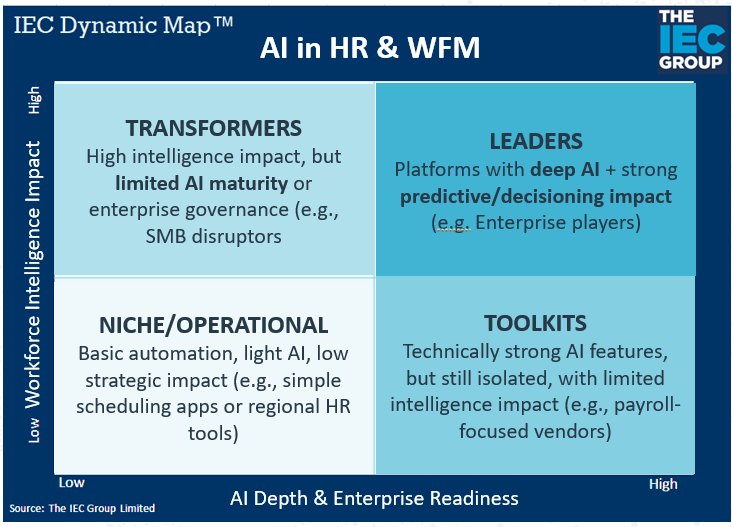The Great Rewire: AI in HR & Workforce Management
Executive Summary
 AI is rewriting the HR playbook. Recent surveys show AI has become a top CHRO priority, and roughly two-thirds of companies are already piloting or using it. The impact is structural: HR is shifting from process administration to product-led, data-driven operations. Talent Acquisition, Employee Services, Learning, and Rewards will be run by small “pods” that ship improvements weekly, while an AI control tower safeguards ethics, compliance, and auditability.
AI is rewriting the HR playbook. Recent surveys show AI has become a top CHRO priority, and roughly two-thirds of companies are already piloting or using it. The impact is structural: HR is shifting from process administration to product-led, data-driven operations. Talent Acquisition, Employee Services, Learning, and Rewards will be run by small “pods” that ship improvements weekly, while an AI control tower safeguards ethics, compliance, and auditability.
Managers evolve into editors and coaches; HRBPs become talent-and-data strategists. Hiring pivots to skills graphs and internal marketplaces; workforce planning blends employees, contractors, and software agents across on-site, remote, and global teams.
To navigate this reset, The IEC Group is launching the AI in HR & Workforce Management Global Study 2026. The program evaluates the provider market across three domains—Talent Intelligence & Development; Workforce Operations & Pay; Employee Experience & People Insights—mapped into nine sub-categories. Results will be published in our IEC Dynamic Map™ Quadrants, aligning AI Depth & Enterprise Readiness with Workforce Intelligence Impact. Participation is free and gives executives a clear view of leaders, forerunners, and scaled innovators—grounded in real use cases, not hype.
The message for 2026: redesign HR now, measure relentlessly, and partner with vendors ready for enterprise scale. The message for now: PARTICIPATE
⇒ Read the full article for free
The Great Rewire: AI in HR & Workforce Management (and Why 2026 Will Reset the Operating Model)
IEC Rebel’s Digest — Special Edition
HR isn’t “rolling out a tool.” It’s rebuilding the engine mid-flight. AI is forcing a total redesign of how we attract, deploy, develop, pay, and protect talent—and it’s reshaping the workforce itself: on-site, hybrid, global, and gig. Over the next 18–24 months, the winners won’t be the companies that dabble in pilots; they’ll be the ones that re-architect HR as a product organization with guardrails, shared data, and human-in-the-loop decisioning.
This piece gives you the ground truth from recent surveys, a plain-English blueprint for restructuring HR, and a first look at The IEC Group’s AI in HR & WFM Global Study 2026—our three-study market analysis with IEC Dynamic Map Quadrants across nine sub-categories. Participation is free, and it will deliver a crisp view of the leaders you should partner with.
What HR leaders say is Priority #1 (and why that’s shifting)
Across the last two annual cycles, CHRO priorities show a meaningful pivot:
- 2025: Gartner’s survey found Leader & Manager Development remained the #1 priority for HR leaders—third year running. In a year of change fatigue and capability gaps, managers were the bottleneck and the multiplier.
- 2026: Gartner’s newest readout elevates AI transformation of HR to the top of the list, closely followed by workforce redesign for the human–machine era, mobilizing leaders for growth, and embedding culture into the flow of work. Translation: capability building is still critical, but the operating model must now be AI-native.
On adoption, the debate is over. Two-thirds (and in many surveys, more) of organizations are already using or piloting AI. McKinsey’s global research shows 65–71% of companies report regular use of generative AI in at least one business function, with overall AI usage in any function near 78%. That’s mainstream, not experimentation.
Inside companies, usage is even more pervasive: three in four knowledge workers say they’re using AI at work today. That’s your workforce moving faster than your governance.
Bottom line: The #1 CHRO priority is now to steer (not stop) this momentum—by building an HR operating model where AI is safe, measurable, and value-creating.
The operating model rewrite: From systems of record → systems of reason & action
Pre-AI HR optimized processes inside systems of record (HRIS, payroll, ATS). Post-AI HR adds two foundational layers:
- Reasoning layer — models that digest policies, past cases, and unstructured data to draft job posts, summarize performance evidence, generate L&D content, and explain decisions.
- Action layer — agents and automations that schedule interviews, triage tickets, run compliance checks, assemble offers, propose workforce plans, and trigger workflows across HR, Finance, IT, and Legal.
To run this safely and at speed, restructure HR around five “mesh” capabilities:
- AI Product Pods (by journey): Talent Acquisition, Employee Services, L&D, Total Workforce, Rewards/Pay. Each pod owns outcomes (time-to-fill, first-contact resolution, time-to-proficiency, pay equity drift, etc.) and ships weekly improvements.
- Responsible AI Control Tower: central policies, model cards, human-in-the-loop tiers, red-teaming, audit logs.
- Skills Cloud & Talent Marketplace: shared ontology that powers hiring, internal mobility, learning paths, and workforce planning by skills, not job titles.
- Knowledge Engine: retrieval-augmented policy and “how-to” content that powers employee and manager assistants.
- Data Contracts & MDM: one set of shared entities (Person, Role, Skill, Cost Center, Location, Assignment) across HR/Finance/IT so agents can act across systems without brittle workarounds.
This isn’t extra bureaucracy. It’s how you scale beyond pilots without chaos.
What actually changes—by HR domain
Talent Acquisition (TA).
- Agentic sourcing revives silver medalists, maps passive talent, and personalizes outreach at scale.
- Structured interviews standardize questions, reduce bias traps, and auto-summarize transcripts—while keeping humans as decision-makers.
- Offer simulation checks internal equity, budget guardrails, and regulatory constraints before a recruiter hits “send.”
Onboarding & Employee Services.
- Concierge assistants resolve most policy, benefits, and payroll questions instantly; edge cases route to humans with context.
- Day-1 acceleration: agents build role-specific learning trails, set up systems access, and coordinate buddy programs.
Learning & Development.
- Skills inference (with explicit consent) from work artifacts and project history feeds hyper-targeted learning.
- Micro-learning generation turns your internal “gold-standard” documents into sequenced, role-relevant learning—pushed at the right moment in the flow of work.
Performance & Rewards.
- Evidence packs assemble feedback, OKRs, customer signals, and outcomes for calibration.
- Pay integrity monitors flag compression and equity drift; scenario engines model adjustments inside budget envelopes.
Workforce Planning.
- What-if planning at the edge: “What if 15% of tier-1 support tickets shift to agents?” “What if we rebalance skill X to nearshore?”
- Blended staffing: plan teams as humans + agents + gig workers, not headcount alone.
The payoff shows up when pods own journey KPIs. That’s where the EBIT shows up too—McKinsey’s adoption curves make clear that value pools accrue to organizations that scale use-cases and measure them, not just pilot them.
The workforce: on-site, remote, global, and gig—designed for humans and agents
AI won’t settle the office vs. remote culture war; it reframes it. Here’s how:
- Office-first organizations will pull AI into co-location advantages: faster creative sprints, whiteboard-to-prototype loops, and manager coaching “in the room.”
- Remote-first organizations will lean into asynchronous, instrumented work: assistants that structure briefs, summarize threads, and tee up decisions; clear audit trails for compliance and quality.
- Global teams gain a genuine follow-the-sun model: hand-offs are packaged by agents; overnight assistants clear queues; local compliance checks run before a human wakes up.
- Gig & total workforce become mainstream: orchestration layers blend employees, contractors, EOR arrangements, freelancers (via VMS/FMS)—plus software agents doing ticket-level tasks. “Team” becomes a living graph of capacity and skills.
This matters for equity and productivity. If AI does the status and coordination work, you can judge performance on outcomes, not proximity. That unlocks fairer hybrid and broader access to global and non-traditional talent.
Governance without friction
Adoption is racing ahead of controls. That’s not hypothetical: multiple global studies show a dramatic surge in AI use by employees, while many organizations lack a plan. Microsoft’s 2024 Work Trend Index reported 75% of knowledge workers already using AI—and leaders acknowledging they need a real strategy.
The move: safe defaults and clear guardrails that flow with work:
- Use-case registry (internally public): purpose, data sources, risk level, owner, and human-in-the-loop requirement.
- Human-in-the-loop tiers: which outcomes must be reviewed (offers, pay changes, terminations, legal comms).
- Model “nutrition labels”: known limits, training sources, escalation criteria.
- Observability: prompt logs, decision trails, and retention aligned with policy and law.
- Manager training: bias pitfalls, explainability basics, and escalation paths.
Make it easy to do the right thing; your people will follow.
KPIs that prove AI is working
You don’t need 50 metrics. You need five that matter per journey:
- TA: time-to-first-slate; recruiter workload per hire; agency spend %; 6-month quality-of-hire proxy.
- Employee Services: first-contact resolution; time-to-resolve; “effort” CSAT.
- L&D: time-to-proficiency by role; skill attainment rate; manager-initiated coaching moments.
- Rewards: calibration variance; pay-equity drift; cycle time reduction.
- Workforce Planning: forecast accuracy by skill; redeployment rate; cost per scenario explored.
Publish a quarterly AI scorecard to the business. Treat it like product analytics, not process reporting.
Monday-morning playbook (first 100 days)
Days 0–10: Draw the map.
Define three outcomes for the next 2 quarters (e.g., “50% faster time-to-fill without equity drift”). Stand up the use-case intake, risk register, and human-in-the-loop tiers.
Days 11–30: Pick three workflows.
Go where value is provable and safe: (1) TA (sourcing + scheduling), (2) Employee Services (policy Q&A + ticket triage), (3) L&D (role-based learning paths). Staff AI Product Pods with a domain lead, a data/ML engineer, a UX/prompt designer, a change partner, and a risk liaison.
Days 31–60: Turn on safe defaults.
Roll out sanctioned assistants, pre-approved model choices, and a curated prompt library. Ship model cards and nutrition labels.
Days 61–100: Scale and securitize.
Wire observability; start workforce planning scenarios; negotiate data contracts with Finance/IT/Legal; publish your first AI scorecard and double-down where KPIs moved.
Introducing the IEC AI in HR & WFM Global Study 2026
To help the market separate signal from noise, The IEC Group has launched the AI in HR & Workforce Management Global Study 2026—a three-part program that analyzes providers by capability, momentum, and customer evidence. We’ll publish IEC Dynamic Map™ Quadrants for each area so leaders can see who’s leading, who’s rising, and where innovation is truly happening.
The three study areas (with nine sub-categories)
Study #1 — AI in Talent Intelligence & Development

- AI-Driven Talent Acquisition (sourcing, screening, scheduling, assessments)
- Performance & Talent Intelligence (evidence packs, calibration, potential signals)
- Learning & Development incl. Internal Mobility/TMarketplaces (content generation, adaptive paths, skills clouds, gigs/assignments, career paths)
Study #2 — AI in Workforce Operations & Pay
4) AI in Scheduling & Time Management (hourly workforce optimization, fairness constraints)
5) AI for Payroll & Compliance (payroll intelligence, anomaly detection, localized rules)
6) Total Workforce Orchestration (VMS/FMS, Contractors, EOR) (one intake for all talent types; rate governance; classification flags)
Study #3 — Employee Experience & People Insights
7) Employee Experience & Virtual Assistants (policy Q&A, case deflection, manager copilots)
8) Workforce Analytics & Planning (skills-based planning, scenario engines, cost/capacity modeling)
How the IEC Dynamic Map Quadrants work
The quadrant plots X-axes: AI Depth & Enterprise Readiness and Y-axes: Workforce Intelligence Impact. Each company displayed is a leader in its category.
 For each sub-category we’ll place vendors using a three-lens model:
For each sub-category we’ll place vendors using a three-lens model:
- Capability Depth — the “can it really do the job?” test (breadth of features, quality, security posture, enterprise readiness).
- Adoption & Scale — evidence of production deployments, global coverage, and customer retention.
- Momentum & Innovation — pace of product improvement, roadmap credibility, and ecosystem gravity.
The output is a quadrant that doesn’t just rank; it guides selection by context. Need a safe pair of hands at global scale? You’ll likely shop the Leaders and Scaled Innovators. Building a greenfield AI pod with unique needs? The Forerunners may be your best collaborators.
Why participate (free)
- For buyers: You get an independent, category-by-category view of the actual AI capabilities, not just marketing adjectives.
- For providers: Participation (no fee) gets your product evaluated in a way enterprise buyers trust—against real buyer criteria and live use-cases.
- For everyone: We’ll publish cross-study insights (what’s real, where the pitfalls are, and which patterns correlate with value).
If you’re a CHRO, CPO, CIO, or a product leader in this space, join the study. It’s free, and it will shortcut months of due diligence.
What this means for your org chart (and your people)
HRBPs become talent + data strategists. They’ll read skills graphs, run scenario conversations with business leaders, and orchestrate redeployment—not just headcount plans.
CoEs morph into product teams. Less policy PDFs, more shipped features: prompts, agents, workflows, and analytics that change behavior in the flow of work.
Managers become editors and coaches. AI does the first draft of the status and the schedule. Managers set context, make calls, and invest in capability.
Employees focus on judgment work. Assistants clear the clutter—notes, summaries, how-to. People tackle customers, creativity, complexity.
Compliance becomes continuous. With AI infused into pay, scheduling, and cross-border work, controls run all the time—not just audit time. That’s crucial as adoption passes the two-thirds mark and regulators sharpen their focus.
The Rebel Bottom Line
- Priority #1 has moved from “train managers” to “transform the operating model”—with managers still at the center. 2025 kept leader/manager development at the top; 2026 puts AI transformation in the #1 spot, with culture and workforce redesign close behind. Build the mesh: pods, control tower, skills cloud, knowledge engine, data contracts.
- Adoption is already mainstream. Multiple surveys show two-thirds or more of companies using genAI or AI in at least one function; three in four knowledge workers say they’re using it at work. Your governance and product muscle must catch up.
- Design for a blended workforce: humans + agents + global + gig. Fair hybrid and borderless teams become practical when AI takes the coordination load and compliance runs continuously.
- Measure journeys, not demos. Five KPIs per journey. Publish a quarterly AI scorecard. Move resources to what works.
- Get an edge with independent intel. Join The IEC Group’s AI in HR & WFM Global Study 2026. You’ll get vendor reality, not vapor—focused on eigth sub-categories and organized in 3 IEC Dynamic Map™ Quadrants that make selection faster, safer, and smarter.
If you’re ready to participate (buyer or provider), say the word to pm@theIECgroup.com—we’ll plug you into the study. The future of HR isn’t “HR vs. AI.” It’s HR with AI—and the sooner you ship your new operating model, the sooner you’ll pull ahead.
Over the next few weeks, we’ll zoom into each of the eight sub-categories in IEC Rebel’s Digest—one deep dive at a time, with practical use cases, KPIs, and the vendor patterns to watch.
IEC Rebel’s Digest— The IEC Group can help you audit your global employment setup by identifying labor leasing risks, verifying licensing requirements, and ensuring your EOR partners meet every compliance standard—before regulators come knocking.
Last but not Least: If you’re facing challenges and wondering how others are managing similar issues, why not join The Leadership Collective Community? It’s a peer group and webcast platform designed for leaders to exchange insights and experiences.
Introducing the IEC Knowledge Network Free Membership – Your Gateway to Seamless Access!
We are thrilled to present a new service that goes beyond the ordinary download experience. In addition to offering you the ability to download the things you love, we are delighted to introduce the IEC Knowledge Network Free Membership.
The Free Membership option grants you access to our library of articles and videos, without the need for tedious registrations for each piece of content.
The publication serves as a trusted resource to support executives in their pursuit of sustainable and successful global expansion. In addition the IEC Practitioners are available to discuss your specific challenge in more detail and to give you clear advise..
Take advantage of this valuable resource to accelerate your global expansion journey

